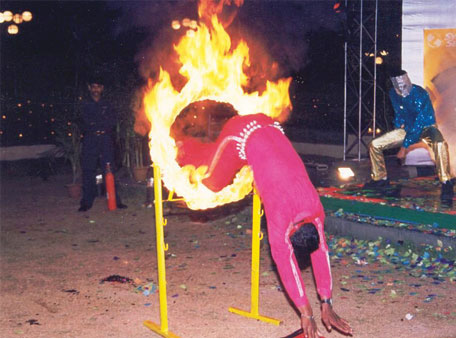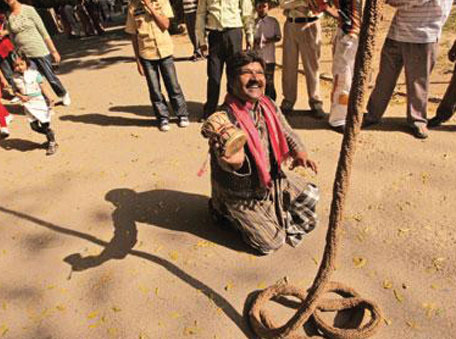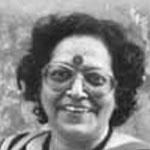OThe word “madari” in Hindi means “street performer”, that is, artists and performers who perform on the streets and depend entirely on the collections from the street audience that collects to watch their performance. Among these are – magicians, jugglers, masqueraders, acrobats, etc. The only man who can find out about these madaris is Ishamuddin Khan, touching 49, who lives in deep poverty in Kathputli Colony, a crowded cluster of tiny homes in west Delhi. Yet, he is forever carrying on almost a one-man crusade, not only to save these fading arts, but more important, to save the artists and performers in this rat-race to basic livelihood when television, cinema, theatre, ipads, smart-phones and tabs have conquered the minds, lives and public spaces of entertainment for the mass media.
“Since Independence in 1947, even the independent government has marginalised us completely. Today, we do not have any officially recognised platform, any package from non-government organisations, as performing artists who have been entertaining the masses for hundreds of years,” says the ever-smiling Ishamuddin, who never wears a sad expression or a solemn face that might reveal his state of mind. He is an entertainer, first and last and his mission is to see that his clan, the madaris and their heirs continue to perform in a way that will rescue them from the dredges of poverty and bring respect and dignity to their lives.
“You will find our presence in literature, in history, in text books for children and on some postage stamps, but the society does not care and the government does not even feel like including us in their plans or packages,” says Ishamuddin. The media has sought to highlight his performance and his clan, but it has done nothing to alleviate his sufferings and those of his co-performing madaris and their families. “Besides the government and the masses, our plight accelerates because we are not educated and we do not know the laws that can protect us and sustain us in the very art we are born into. We know nothing about our rights and therefore, we do not know how to claim them, “says Ishamuddin.
The Great Indian Rope Trick!
Ishamuddin claims to have revived the Great Indian Rope Trick, which he performed in the presence of a mass audience in 1995, and has therefore, disproved myths that the legendary trick was only a figment of fevered Western imagination. What is this trick we all have heard about but never seen? In the classic version of the Indian rope trick the performer first causes a rope to rise into the air. His boy assistant then scurries up the rope and promptly disappears. Next, the performer climbs the rope after the boy and also vanishes. Moments later, dismembered parts of the boy’s body fall to the ground. The performer now descends the rope and places these parts into a basket. Finally, the boy jumps from the basket, fully restored to life. This legendary rope trick has generated over a hundred years of debate among scientists, psychical researchers, journalists, magicians and the public.

What motivated him to revive, teach himself and then perform the rope trick? “I had heard lots of stories around this trick since I was a child. Then, an American writer told me that an award was being offered to anyone who could perform the trick. I made up my mind to crack the mystery. So, I got sucked into the world of research, trying to dig as much information and knowledge as I could from different sources, from Jehangir Nama to Siegel’s Net of Magic, and all this while, my mother and my wife would keep the family kitchen burning with their job of rag-picking. But, though I performed the trick, I never got the money,” he says without rancour.
Ishamuddin completed the first successful outdoor performance in view of a collected public of a trick everyone has been talking about for hundreds of years, but no one has mastered before. His performance made headlines around the world media and amazed the mesmerised audience, but sadly, did nothing to improve his financial condition or his lifestyle. If his quality of life cannot improve, how will the lives of other street performers improve? Ishamuddin is among the top twenty street magicians of the world; but back home he is a madari fighting for sustenance of his livelihood; and struggling hard to bring all traditional street artists some semblance of living a life of dignity.
A union of street performers
The street performers now have an association founded under the leadership of Ishamuddin who founded the Indian Street Performers’ Association Trust (ISPAT) in 2013, which has a website of its own, and a page on a social networking site. “I have travelled across continents and have been featured on international television channels like BBC and CNN, and have got recognition for my individual performances. But that does not fulfil my desire to see my clan sustain. Many of our children have drifted away from their ancestral occupation because it does not feed them anymore. I want to revive the interest in street performances and performers. And so I decided to found ISPAT and many of my ilk backed this decision,” informs Ishamuddin.

The Indian Street Performers Association Trust has been set up to revive the traditional street performances or madari traditions in India. This is an initiative by the street performer community for their own community. They have recently got 80G and 12A approval from the government to raise funds. There are seven street performing communities in India – Street Magicians, Acrobats, Snake Charmers, Street Singers, Jugglers, Impersonators or Beherupiyas and Animal Trainers.
When Ishamuddin performed for and got acquainted with Irish gypsies during his travels, he learnt how they work for the betterment of their folk gypsies, and he decided to do the same for his peers in India. He decided to work towards the uplift and betterment of Indian street performers. “So after meeting intellectuals and arts lovers, organisations, visiting colleges and universities, I decided to form this organisation towards giving them an identity, work towards their empowerment, polish their performances, arrange and organise funds and sponsors so that we can participate in art festivals, education programmes, leadership programmes, community training programmes, competitions and conventions. We are trying to get our cultural ancestry back through our performances in our cities and villages,” says Ishamuddin.
Those who wish to donate should contact Ishamuddin Khan at 9811730682 or write to him at ispatstreet@gmail.com. Donations can be made directly to the following account:
Name of Account: Indian Street Performers Association Trust (ISPAT)
A/c No: 172500101003875
Name of Bank: Corporation Bank
Branch: 1725 Delhi-West Patel Nagar
Branch Address: Cottage No.3A Ground Floor West Patel Nagar
New Delhi-110008
IFSC Code: CORP0001725
MICR Code: 110017130
If you donate directly, please send a mail to ispatstreet@gmail.com with your name, address and mobile number so that a receipt can be sent to you. All donations to ISPAT are tax deductible.
He now does performances at birthday parties on invitation and helps his co-street performers to do likewise. His wife tends to the homestead by earning a pittance with all kinds of odd jobs. “So long as the British ruled India, street performers earned respect because of their command over the skill and art of traditional performance. Our children looked forward to learning the family’s ancestral art. But with Independence, we are constantly made victims of police harassment and torture. We are considered to be beggars, which we most certainly are not. Many street performers are forced to take up casual jobs as day labourers at construction sites and other indigenous workshops. The only way left for us to earn through our art are birthday parties,” he sums up.


 [/column]
[/column]